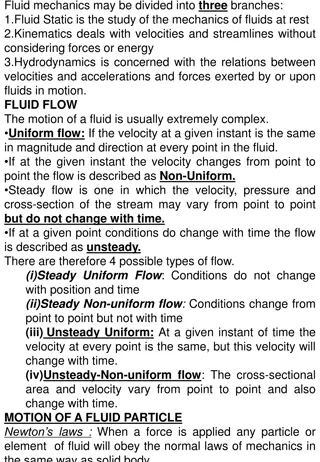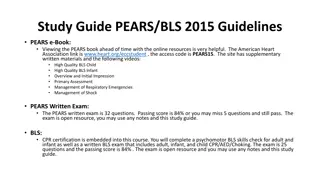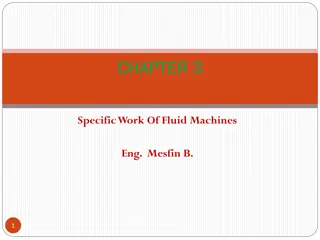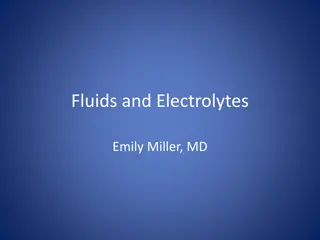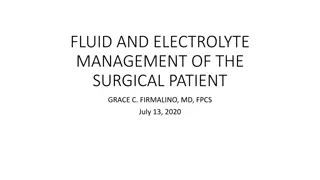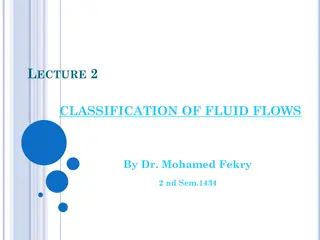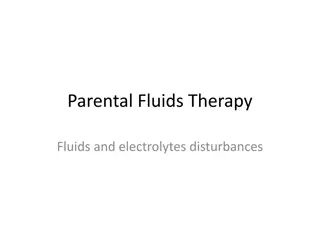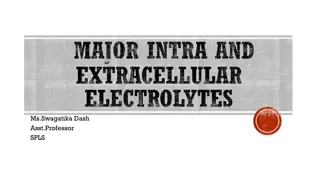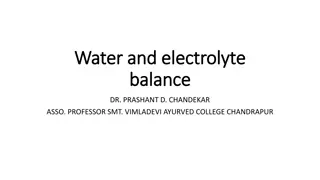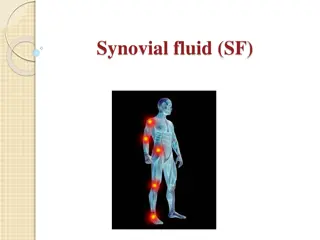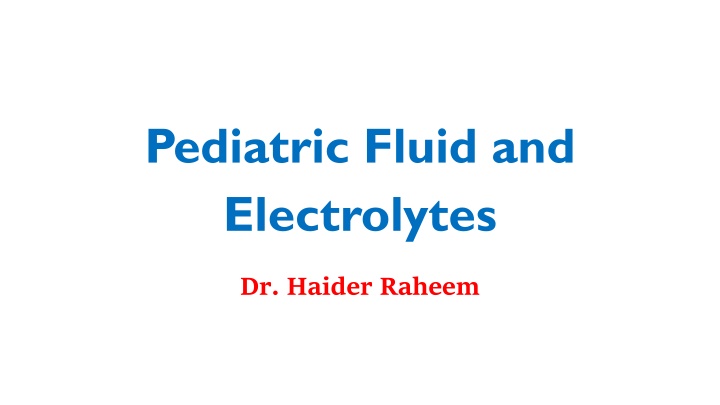
Pediatric Fluid and Electrolyte Management
This content provides detailed information on pediatric fluid and electrolytes management, including fluid distribution, intravenous fluid types, common crystalloid solutions, calculation of maintenance fluid and electrolyte requirements for infants. It covers guidelines for estimating fluid, sodium, and potassium needs based on weight, as well as practical examples and calculations for maintaining electrolyte balance. Essential reading for healthcare professionals involved in pediatric care.
Download Presentation

Please find below an Image/Link to download the presentation.
The content on the website is provided AS IS for your information and personal use only. It may not be sold, licensed, or shared on other websites without obtaining consent from the author. If you encounter any issues during the download, it is possible that the publisher has removed the file from their server.
You are allowed to download the files provided on this website for personal or commercial use, subject to the condition that they are used lawfully. All files are the property of their respective owners.
The content on the website is provided AS IS for your information and personal use only. It may not be sold, licensed, or shared on other websites without obtaining consent from the author.
E N D
Presentation Transcript
Pediatric Fluid and Electrolytes Dr. Haider Raheem
Fluid Management Figure 7-1: Distribution of total body fluid.
Table 7-1: Distribution of Intravenous Fluid. Intravenous Fluid Infused Volume (mL) Equivalent Intravascular Expansion (mL) Volume Normal saline Lactated Ringer solution Normosol-R and Plasma- Lyte 1000 1000 1000 250 250 250 5% Dextrose Albumin 5% Albumin 25% Hydroxyethyl starch 6% 1000 500 100 500 100 500 500 500
Table 7-2: Content of Common Crystalloid Solutions. Contents (mEq/L) Na 154 Cl 154 Na 130 Cl 109 K 4 Ca 3 Lactate 28 Osmolarity (mOsmol/L) Sodium chloride 0.9% (NS) Lactated Ringer (LR) 308 273
Calculation of Maintenance Fluid and Electrolyte Requirements P.J., a 2-day-old, 3.5-kg term female infant has developed abdominal distension, and her oral feedings have been stopped. Calculate a maintenance fluid and electrolyte prescription for her. Her serum electrolytes include the following: Sodium, 137 mEq/L Potassium, 4.2 mEq/L Chloride, 105 mEq/L HCO 3, 23 mEq/L While P.J. receives nothing by mouth (NPO), her fluid and electrolyte needs must be met intravenously. Estimate her requirements.
Calculation Electrolyte Requirements of Maintenance Fluid and Fluid, electrolyte, and nutrient requirements on the basis of weight are provided in Table 7-1. Although a commercially available intravenous solution will be used, each component of the solution can be calculated separately. Using the guidelines in Table 7-3, P.J. s maintenance requirements can be estimated as follows: Fluid 100 mL/kg/day 3.5 kg = 350 mL/day or 15 mL/hour Sodium 2 4 mEq/kg/day 3.5 kg = 7 14 mEq/day Potassium 2 3 mEq/kg/day 3.5 kg = 7 10.5 mEq/day
Calculation Electrolyte Requirements of Maintenance Fluid and Fluid and electrolyte requirements can be met by infusing a solution of 5% dextrose with one-quarter NS (38 mEq/L) and 20 mEq/L of KCl at 15 mL/hour. This provides 12 mEq (3.4 mEq/ kg/day) of NaCl and 7 mEq (2 mEq/kg/day) of KCl in 360 mL (103 mL/kg/day) of fluid per day.
Nutrient Fluid Weight/Age <1.5 kg 1.5 2.5 kg 2.5 10 kg 10 20 kg >20 kg Up to 10 kg 20 kg >20 kg Infants Older children Adolescents and older Infants and children >50 kg Infants and children Infants and children Infants and children Preterm and term infants Children >1 year (or >12 kg) Preterm and term infants Children >1 year (or >12 kg) Preterm and term infants Children >1 year (or >12 kg) Requirement 150 mL/kg 120 mL/kg 100 mL/kg 1,000 mL + 50 mL/kg for each kg >10 kg 1,500 mL + 20 mL/kg for each kg >20 kg 100 kcal/kg 1,000 kcal + 50 kcal/kg for each kg >10 kg 1,500 kcal + 20 kcal/kg for each kg >20 kg 2 3 g/kg 1.5 2.0 g/kg 1.0 1.5 g/kg Initially 0.5 1 g/kg then increase by 0.5 1 g/kg One 500-mL bottle (100 g fat) 2 4 mEq/kg 2 3 mEq/kg 2 4 mEq/kg 0.25 0.5 mEq/kg 4 12 mEq 2 3 mEq/kg 10 20 mEq 1.0 1.5 mmol/kg 10 20 mmol Calories Table 7-3: Daily Parenteral Nutrient Requirements in Children. Protein Fat Sodium Potassium Chloride Magnesium Calcium Phosphorus
Dehydration H.S. is a 2-year-old lethargic girl with a 2-day history of vomiting and minimal oral intake. Yesterday, she required only three diaper changes instead of her usual eight and has needed only one change today. Her vital signs are as follows: Temperature, 39 C Pulse, 140 beats/minute (normal, 80 130 beats/minute) Respiratory rate, 30 breaths/minute (normal, 30 35 breaths/minute) Blood pressure (BP), 80/45 mm Hg (normal, 80 115 mm Hg systolic and 50 80 mm Hg diastolic) On physical examination, her eyes appear sunken, her mucous membranes are dry, and her skin is dry and cool to touch. Although she is crying, there are no tears, and the skin over her sternum tents when pinched. Her weighttoday is 11.4 kg; 3 weeks ago, it was 12.9 kg. What do these findings represent? What immediate treatment should be provided?
Dehydration H.S. s lethargy, decreased urine output, tearless crying, dry mucous membranes, dry skin with fever, sunken eyes, mild tachycardia with low normal blood pressure, and poor skin turgor are all signs of dehydration. This is consistent with her 2-day history of vomiting and poor intake. Her weight loss of 1.5 kg gives a further clue to the extent of dehydration. Dehydration or fluid loss is determined most accurately by weight loss. Because 1 g of body weight is approximately equal to 1 mL, her fluid deficit is estimated to be 1,500 mL. The percentage dehydration is estimated using the following formula:
Dehydration Actual body weight Normal body weight % ?? ???????? = ?????? ???? ???? ? 100 Tachycardia and marginal blood pressure dictate the need for immediate IV rehydration. Normal serum sodium concentration ranges from 135 to 145mEq/L of sodium; thus, normal saline approximates the sodium concentration of plasma and is often used as a volume expander. In this patient, 10 to 20 mL/kg of normal saline (12.9 kg 10 to 20 mL/kg = 129 to 258 mL) should be infused as rapidly as possible to establish normal blood pressure. For symptomatic patients, including those with seizures, the serum sodium concentration should be increased acutely only to the degree necessary to abate symptoms.
Dehydration Calculate H.S. s fluid and electrolyte needs. Her serum electrolyte results were as follows: Sodium, 128 mEq/L (normal, 135 145 mEq/L) Potassium, 3.1 mEq/L (normal, 3.5 5 mEq/L) Chloride, 88 mEq/L (normal, 102 109 mEq/L) HCO 3, 30 mEq/L (normal, 22 29 mEq/L)
Dehydration In addition to normal maintenance fluids, H.S. must be provided with fluids and electrolytes to replace her deficit secondary to dehydration and compensate for increased insensible water loss because of fever. Each component of the fluid can be calculated separately. Fluid deficit = Weight loss (kg) 1,000 mL/kg Fever adjustment = 10% Maintenance for each C 37 C (CD CO) Fd Weight = mEq required where CD is the concentration of sodium desired (mEq/L), CO is the concentration observed (mEq/L), Fdis the apparent distribution factor as a fraction of body weight (Table 7-4), and weight is the baseline weight before illness (kg). In consideration of both maintenance needs and current deficits, fluid and electrolyte requirements for H.S. would be estimated as follows.
Table 7-4: Electrolytes and Apparent Distribution. Electrolyte Fd(L/kg) Sodium 0.6 0.7 Bicarbonate 0.4 0.5 Chloride 0.2 0.3 Fd, apparent distribution factor as a fraction of body weight.
FLUID Maintenance Fever Deficit 1,000 mL + (50 2.9) = 1,145 mL 2 C 0.1 (1,145) = 229 mL 1.5 kg 1,000 mL/kg = 1,500 mL Total fluid = 2,874 mL SODIUM Maintenance Deficit 3 mEq/kg 12.9 kg = 38.7 (135 128 mEq/L) 0.6 L/kg 12.9 kg = 54.2 Total sodium 93 mEq
CHLORIDE H.S. has a mild metabolic alkalosis as evidenced by her serum chloride of 88 mEq/L and her serum bicarbonate of 30 mEq/L. This is most likely because of the loss of hydrogen and chloride in her vomitus. Thus, both the sodium and potassium replacements should be administered as chloride salts. POTASSIUM Potassium is primarily an intracellular ion. It moves in and out of cells in exchange for hydrogen ions to maintain a normal blood pH. Therefore, in metabolic alkalosis, the intracellular shift of potassium will decrease the serum potassium concentration.
POTASSIUM When the pH normalizes, as will occur with rehydration, the hydrogen ions will move intracellularly extracellularly, thus causing the serum potassium concentration to increase. Additionally, potassium is also excreted by the kidney in exchange for hydrogen ion conservation. These factors make the serum potassium concentration difficult to interpret. Intravascular volume depletion causes hypoperfusion of the kidney and can result in acute renal failure; therefore, the prudent approach is to give no potassium until urine output is clearly established. Then, only maintenance doses of potassium should be administered until a normal acid base and fluid status are established and the serum potassium can be assessed more accurately. Hence, H.S. should receive approximately 26 to 39 mEq of potassium (2 3 mEq/kg 12.9 kg) once urine flow is established. and the potassium will move
Administration of Fluid Requirements How should these calculated needs be given? Requirements for the first 24 hours of parenteral fluid therapy should provide approximately 2,875 mL of fluid to account for maintenance fluid needs, fever replacement, and deficit replacement. In addition to fluid, at least 93 mEq of sodium (maintenance needs plus deficit replacement) should be provided in the first 24 hours. It is important to provide sufficient amounts of sodium and water.
Administration of Fluid Requirements Rehydration fluids are usually dispensed in volumes less than the 24- hour requirement. This is to prevent wasting IV fluids caused by changes in electrolyte needs during replacement therapy. Because this patient requires approximately 3 L of fluid, only 1 L would be prepared initially, and this would likely consist of dextrose 5% and 0.2% NS (or greater). Approximately 15 mEq/L of potassium would be added to the next liter of IV solution if the patient had a reasonable urine output.
Administration of Fluid Requirements The infusion rate should be calculated to provide one-third of the daily maintenance fluid plus one-half of the deficit replacement during the first 8 hours. The remainder of the maintenance fluid (adjusted for fever) and deficit replacement should be administered during the next 16 hours. Usually, serum electrolytes are monitored every 6 to 8 hours during rehydration therapy to ensure that appropriate electrolytes are being provided. Usually, the concentration of serum electrolytes is monitored frequently during fluid replacement therapy of deficits. In general, the serum sodium concentration should not be increased by more than 10 to 12 mEq/L/day. After the initial fluid deficits are replaced, the infusion rate of the IV fluid would be decreased to 48 mL/hour (1,152 mL or approximately maintenance fluid rate).




